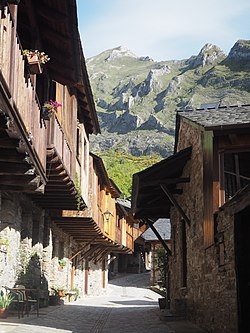El Bierzo
El Bierzo | |
|---|---|
Comarca | |
 | |
|
UTC+2 (CEST) | |
| Largest municipality | Ponferrada |


El Bierzo (Spanish pronunciation:
The territory of El Bierzo includes most of the upper basin of the Sil river. It is surrounded by mountains on all sides, which makes this area remarkably isolated from all neighbouring lands.
History
In pre-Roman times the region was populated by the
Historically part of the
.El Bierzo developed its own peculiarities as
The status of El Bierzo as a shire is recognized by law, and it is the only one officially recognized in the
Languages
The predominant language nowadays is Spanish but the local vernaculars can be classified as either Galician or Leonese; the Galician traits increase as one moves from east to west. The use of Galician and Leonese in everyday speech has mixed usages. Although both have enjoyed a recent revival through the work of different associations that promote their use and study, Galician has been more favored, extending its area of influence. Leonese continues to have a very limited use.
The Galician language, in addition to Galicia, is also spoken in western El Bierzo and a small area called As Portelas in the westernmost part of the
Pachuezu or patsuezu is the western Asturleonese variant most entrenched in the north of El Bierzo, where there are estimated to be about 4,000 speakers of Leonese.
Economy
The railroad arrived in the region in 1881, and during World War I local
Starting in the late 1980s most mines were closed, and after the collapse of the mining industry the region was for a while in a crisis. However, in the late 1990s the region underwent a major transformation with the establishment of several industrial and services firms, the reintroduction of commercial wine production, the opening of a local branch of the
Important factors contributing to the recent boom of the tourism industry in the region are the increasing popularity of the
See also
References
- ^ http://www.fundacionlasmedulas.org/index.jsp
- ^ "El Bierzo en la Historia" (in Spanish). Archived from the original on 2006-06-12. Retrieved 2007-01-30.
- ^ Richard A. Fletcher (1978) The Episcopate in the Kingdom of León in the Twelfth Century (Oxford: Oxford University Press), 49.
- ^ "Castilla y León". Xunta de Galicia. Archived from the original on 11 March 2012. Retrieved 4 May 2012.
- ^ Galiza, Sermos (12 June 2015). "Carta dun alumno que quere estudar galego". Sermos Galiza (in Galician). Retrieved 2016-05-21.
- ^ http://www.fundacionlasmedulas.org/index.jsp
External links
- El Bierzo Regional Council Official Website (in Spanish)
- Consejo Regulador de la Denominación de Origen Bierzo (in Spanish)
- Instituto de Estudios Bercianos (in Spanish)
